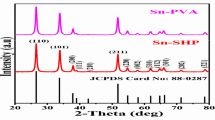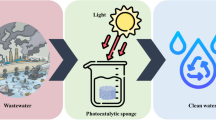Abstract
Non-ionic surfactants are permanent components of wastewater of various origins, and their removal is necessary for sewage treatment. A new method of electrochemical treatment of wastewater for non-ionic surfactant destruction has been proposed. Effective destruction of both alkoxylated and phenoxylated non-ionic surfactants was performed using β-Pb1–xBixO2–0.5x anodes prepared by electrodeposition. The method proposed is based on the generation of active oxygen-containing species (e.g., OH•, HO2•) at the anode followed by chemical interaction between these radicals and organic molecules, which results in the destruction of pollutants. Oxide materials obtained by electrodeposition contained ~ 4.5 % of bismuth and have the β–PbO2 lattice. The insertion of bismuth into the composition of lead dioxide prepared by electrodeposition resulted in an increase in their specific surface area from 0.66 to 2.5 m2 g−1. Modification of β–PbO2 by bismuth led to the shift of oxygen evolution potentials toward more positive values. Effective electrooxidation of non-ionic surfactants was achieved in the solutions exposed to electrochemical treatment. There were no accumulations of metabolites in the solutions during electrolysis. Chemical oxygen demand decreased from 80 to 5 mg O2 dm−3, and total organic carbon (TOC) decreased from 24 to 1.5 ppm during 1 h of the electrochemical treatment. The electrode material was stable under electrolysis conditions. No accumulation of both lead and bismuth species in the solution under electrochemical treatment was found.







Similar content being viewed by others
References
Pagano M, Lopez A, Volpe A, Mascolo G, Ciannarella R (2008) Oxidation of non-ionic surfactants by Fenton and H2O2/UV processes. Environ Technol 29:423–433
Goncharuk VV, Klishchenko RR, Kornienko IV (2017) Destruction of nonionic surfactants in a plasma-chemical reactor. J Water Chem Technol 39:355–359
Czech B, Cwikla-Bundura W (2012) Advanced oxidation process in Triton X-100 and wah-up liquid removal from wastewater using modified TiO2/Al2O3 photocatalysts. Water Air Soil Pollut 223:4813–4822
Sima J, Holcova V (2011) Removal of non-ionic surfactants from wastewater using a constructed wetland. Chem Biodivers 8:1819–1832
Kwiatkowski M, Chassagnon R, Geoffroy N, Herbst F, Heintz O, Bezverkhyy I, Skompska M (2017) Enhancement of visible light photoelectrocatalytic activity of ZnO(core)/TiO2(shell) composite by N-doping and decorating with Au0 nanoparticles. Electrochim Acta 246:213–225
Kwiatkowski M, Chassagnon R, Heintz O, Geoffroy N, Skompska M, Bezverkhyy I (2017) Improvement of photocatalytic and photoelectrochemical activity of ZnO/TiO2 Core/Shell system through additional calcination: insight into the mechanism. Appl Catal B 204:200–208
Dong H, Zeng G, Tang L, Fan C, He X, He Y (2015) An overview on limitations of TiO2-based particles for photocatalytic degradation of organic pollutants and the corresponding countermeasures. Water Res 79:128–146
Ferreira MB, Bezerra Rocha JH, da Silva DR, de Moura DC, de Araujo DM, Martinez-Huide CA (2016) Application of electrochemical oxidation process to the degradation of the Novacron Blue dye using single and dual flow cells. J Solid State Electrochem 20:2589–2597
Hu X, Yu Y, Yang L (2015) Electrocatalytic activity of Ce-PbO2/C anode for acid red B reduction in aqueous solution. J Solid State Electrochem 19:1599–1609
Labiadh L, Barbucci A, Cerisola G, Gardi A, Ammar S, Panizza M (2015) Role of anode material on the electrochemical oxidation of methyl orange. J Solid State Electrochem 19:3177–3183
Pereira JF, Figueiredo RS, Ponce-de-Leon C, Bertazzoli R (2016) Platinum-free lead dioxide electrode for electrooxidation of organic compounds. J Solid State Electrochem 20:1167–1173
Santos JEL, de Moura DC, da Silva DR, Panizza M, Martinez-Huide CA (2019) Application of TiO2-nanotubes/PbO2 as an anode for the electrochemical elimination of Acid Red 1 dye. J Solid State Electrochem 23:351–360
Zaidi SZJ, Harito C, Walsh FC, Ponce de Leon C (2018) Decolourisation of reactive black-5 at an RVC substrate decorated with PbO2/TiO2 nanosheets prepared by anodic electrodeposition. J Solid State Electrochem 22:2889–2900
Perkowsky J, Mayer J, Kos L (2005) Reactions of non-ionic surfactants, Triton X-n type, with OH radicals: a review. Fibres Text East Eur 13:81–85
Armstrong DA, Huie RE, Lymar S, Koppenol WH, Merenyi G, Neta P, Stanbury DM, Steenken S, Wardman P (2013) Standard electrode potentials involving radicals in aqueous solution: inorganic radicals. BioInorg React Mech 9:59–61
Chi H, Wan J, Ma Y, Wang Y, Ding S, Li X (2019) Ferrous metal-organic frameworks with strongly unsaturated metal sites for persulfate activation to efficiently degrade dibutyl phthalate in wasterwater. J Hazard Mater 377:163–171
Shih Y-L, Huang C-P, Chan Y-H, Huang Y-H (2019) Electrochemical degradation of oxalic acid over highly reactive nano-textured γ- and α-MnO2/carbon electrode fabricated by KMnO4 reduction on loofah sponge-derived active carbon. J Hazard Mater 379 Article 120759
Patel PS, Bande N, Sarat A, Ruparelia JP (2013) Electrocatalytic materials (electrode materials) in electrochemical wastewater treatment. Process Eng 51:430–435
Kapalka A, Foti G, Comninellis C (2009) The importance of electrode material in environmental electrochemistry: formation and reactivity of free hydroxyl radicals on boron-doped diamond electrodes. Electrochim Acta 54:2018–2023
Lissens G, Pieters J, Verhaege M, Pinoy L, Verstraete W (2003) Electrochemical degradation of surfactants by intermediates of water discharge at carbon-based electrodes. Electrochim Acta 48:1655–1663
Baohong G, Yadong Z, Yuling L (2010) A new cleaning process combining non-ionic surfactant with diamond film electrochemical oxidation for polished silicon wafers. J Semicond 31 Article 076002
Nurhayati EA (2012) A brief review on electro-generated hydroxyl radical for organic wastewater mineralization. JSTL 4:24–31 https://journal.uii.ac.id/index.php/JSTL/about
Wu T-N (2007) Electrocatalytic oxidation of methyl tert-butyl ether (MTBE) in aqueous solution at a nickel electrode. Chemosphere 271:271–278
Xu L, Ma X, Niu J, Chen J, Zhou C (2010) Removal of trace naproxen from aqueos solution using a laboratory-scale reactive flow-through membrane electrode. J Hazard Mater 379 Article 120692
Ai S, Wang Q, Li H, Jin L (2005) Study on production of free hydroxyl radical and its reaction with salicylic acid at lead dioxide electrode. J Electroanal Chem 578:223–229
Liu M, Tang Y-N, Wang L, Hu Y-D, Jiao X-Q, Huang W-P (2008) Degradation of phenol by hydroxyl radicals on different coatings lead dioxide electrodes. Chem Res Chin Univ 24:285–290
Zhou M, Dai Q, Lei L, Churtian MA, Wang D (2005) Long life modified lead dioxide anode for organic wastewater treatment: electrochemical characteristics and degradation mechanism. Environ Sci Technol 39(1):363–370
Zhao G, Zhang Y, Lei Y, Lv B, Gao J, Zhang Y, Li D (2010) Fabrication and electrochemical treatment application of a novel lead dioxide anode with superhydrophobic surfaces, high oxygen evolution potential, and oxidation capability. Environ Sci Technol 44(5):1754–1759
Labiadh L, Barbucci A, Carpanese MP, Gadril A, Ammar S, Panizza M (2017) Direct and indirect electrochemical oxidation of indigo carmine using PbO2 and TiRuSnO2. J Solid State Electrochem 21:2167–2175
Souza FL, Aquino JM, Irikura K, Miwa DW, Rodrigo MA, Motheo AJ (2014) Electrochemical degradation of the dimethyl phthalate ester on a fluoride-doped Ti/β-PbO2 anode. Chemosphere 109:187–194
Popovic NÐ, Cox JA, Johnson DC (1998) A mathematical model for anodic oxygen-transfer reactions at Bi(V)-doped PbO2-film electrodes. J Electroanal Chem 456:203–209
Shmychkova O, Luk’yanenko T, Velichenko A (2013) Bismuth doped PbO2 coatings: morphology and electrocatalytic properties. Univers J Chem 1:30–37 http://www.hrpub.org/journals/jour_info.php?id=64
Tahar NB, Savavall A (1999) Electrochemical degradation of phenol in aqueous solution on bismuth doped lead dioxide: a comparison of the activities of various electrode formulations. J Appl Electrochem 29:277–283
Trasatti S, Petrii OA (1992) Real surface area measurements in electrochemistry. J Electroanal Chem 327:353–376
Jung S, McCrory CCL, Ferrer IM, Peters JC, Jaramillo TF (2016) Benchmarking nanoparticulate metal oxide electrocatalysts for the alkaline water oxidation reaction. J Mater Chem A 4:3068–3076
Sekiguchi O, Ayuzawa T, Fujishige M, Yanagisawa T, Tajima S (1995) Fragmentation processes of 1,2-diphenoxyethane and 2-phenoxyethanol by electron impact. Rapid Commun Mass Spectrom 9:75–81
Radjenovich J, Sedlak DL (2015) Challenges and opportunities for electrochemical processes as next-generation technologies for the treatment of contaminated water. Environ Sci Technol 49:11282–11302
Jasper JT, Yang Y, Hoffman MR (2017) Toxic byproduct formation during electrochemical treatment of latrine wastewater. Environ Sci Technol 51(12):7111–7119
Shmychkova O, Luk’yanenko T, Velichenko A, Meda T, Amadelli R (2013) Bi-doped PbO2 anodes: electrodeposition and physico-chemical properties. Electrochim Acta 111:332–338
Liu Y, Liu H (2008) Comparative studies on the electrocatalytic properties of modified PbO2 anodes. Electrochim Acta 53:5077–5083
Zhou K, Tian Y, Ma H, Ma CH, Fu Y, Dong X, Zhang X (2018) Photoelectrocatalytic performance of conductive carbon black-modified Ti/F-PbO2 anode for degradation of dye wastewater (reactive brilliant blue KN-R). J Solid State Electrochem 22:1131–1141
Comninellis C (1994) Electrocatalysis in the electrochemical conversion/combustion of organic pollutants for waste water treatment. Electrochim Acta 39:1857–1862
Martinez-Huitle CA, Rodrigo MA, Sires I, Scialdone O (2015) Single and coupled electrochemical processes and reactors for the abatement of organic water pollutants: a critical review. Chem Rev 115(24):13362–13407
Shannon RD, Prewitt CT (1969) Effective ionic radii in oxides and fluorides. Acta Cryst B 25:925–946
He X, Xu P, Mao J, Tang Y (2019) Electrodeposition and performance of Ti/SnO2-Sb/PbO2 electrodes from methanesulfonate baths. J Electrochem Soc 166:D452–D459
Chen HY, Wua L, Rena C, Luob QZ, Xiea ZH, Jianga X, Zhuc SP, Xiad YK, Luo YR (2001) The effect and mechanism of bismuth doped lead oxide on the performance of lead-acid batteries. J Power Sources 95:108–118
Kuznetsov VV, Shmakova OA, Kolesnikov VA, Evseev AK, Volkov AG, Goldin MM (2008) Electrochemical behavior of manganese–molybdenum oxide anodes in chloride–sulfate aqueous solutions. J Electrochem Soc 155:D671–D674
Santos JEL, Quiroz MA, Cerro-Lopez M, de Moura DC, Martinez-Huitle CA (2018) New J Chem 42:5523–5531
Amadelli R, Velichenko AB (2001) Lead dioxide electrodes for high potential anodic processes. J Serb Chem Soc 66:835–845
Kumada N, Kinomura N, Woodward PM, Sleight AW (1995) Crystal structure of Bi2O4 with β–Sb2O4–type structure. J Solid State Chem 116:281–285
Author information
Authors and Affiliations
Corresponding author
Additional information
Publisher’s note
Springer Nature remains neutral with regard to jurisdictional claims in published maps and institutional affiliations.
Rights and permissions
About this article
Cite this article
Kuznetsov, V.V., Kapustin, E.S., Pirogov, A.V. et al. An effective electrochemical destruction of non-ionic surfactants on bismuth-modified lead dioxide anodes for wastewater pretreatment. J Solid State Electrochem 24, 173–183 (2020). https://doi.org/10.1007/s10008-019-04483-3
Received:
Revised:
Accepted:
Published:
Issue Date:
DOI: https://doi.org/10.1007/s10008-019-04483-3




